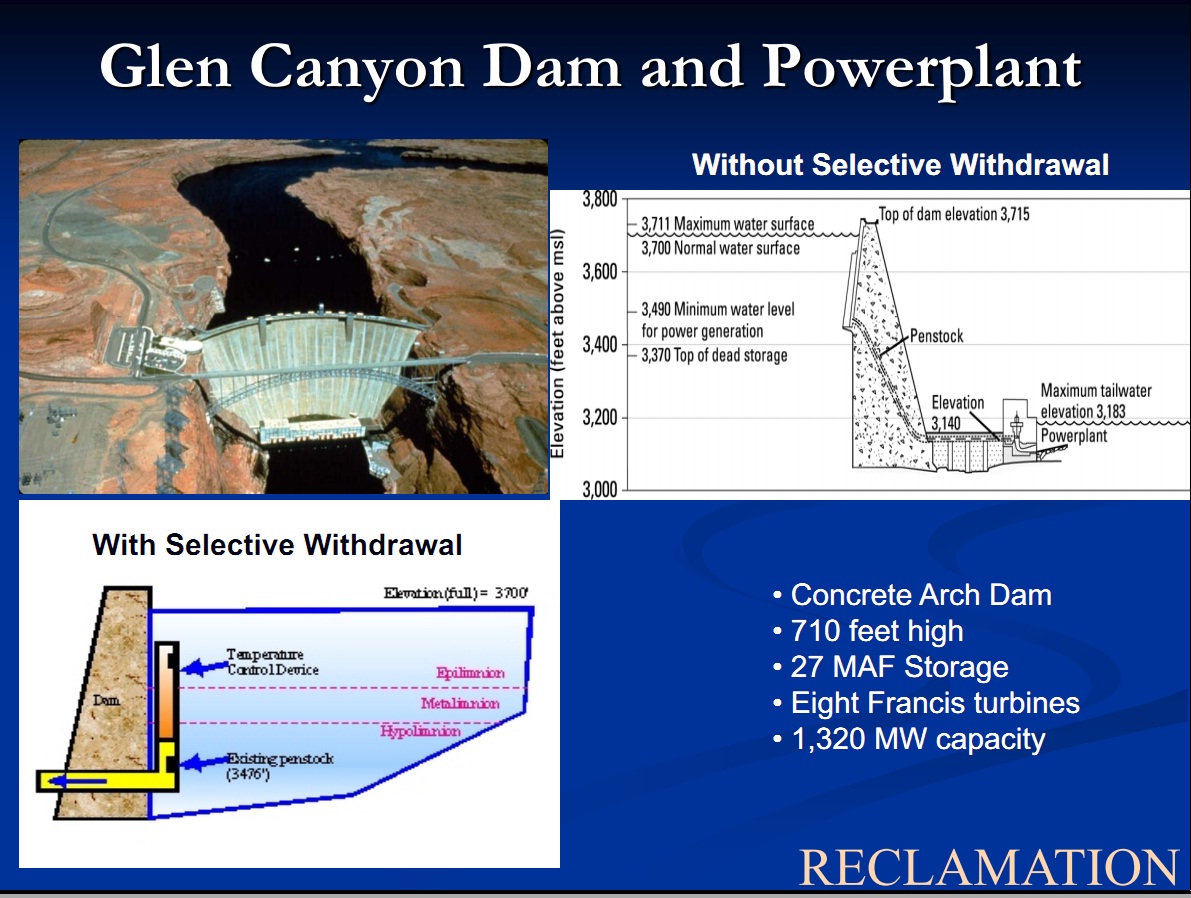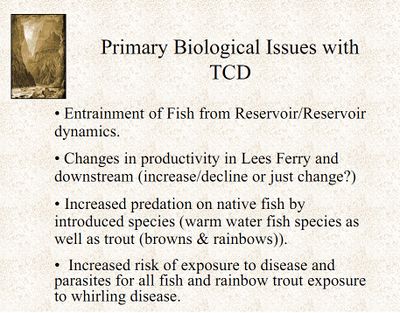Updates
|
- Record Colorado River flow reductions averaged 19.3% per year during 2000-2014. One-third or more of the decline was likely due to warming.
- Unabated greenhouse gas emissions will lead to continued substantial warming, translating to twenty-first century flow reductions of 35% or more.
- More precipitation can reduce the flow loss, but lack of increase to date and large megadrought threat, reinforce risk of large flow loss.
Why less water? 2000-14 Temperatures are 1.6°F above 1906-99 Average
- Longer growing season
- More warmth on any given day
- At some point, possibly more plants and growth upslope
- More evaporation from soils
- More opportunity for sublimation
- More atmospheric demand
Since the late 1980s increases in temperature have caused a substantial reduction in runoff efficiency. Over the last 3 decades temperature has reduced the flow by 7% [2]
|
Need for a warm-water or a cold-water TCD
|
Warm-water TCD
- increase native fish growth (and survival)
- increase foodbase production and diversity
Cold-water TCD
- decrease threat of nonnative fish proliferation
- provide cold water to sustain the Lees Ferry trout fishery
|
1999 TCD Effort
|
|
Many scientists and the FWS believe the ability to increase the dam's discharge temperature is a key element in the recovery of native fish near the Little Colorado River. Reclamation has prepared an Environmental Assessment (EA), with subsequent peer review, on the proposed temperature control modifications and its potential impacts. The peer review, completed April 1999 and the draft Plan and EA, completed January 1999, are available for on-line viewing and as a download for off-line viewing (download). (Online viewing is NOT recommended for slow 56/28.8KB) connections). Based on an open, public review of the EA and further consultation with the FWS, Reclamation will decide whether or not to proceed with the $15 million modification. Construction may start as soon as FY-2000 and would be completed in approximately two years. Post construction testing would be accomplished by the Grand Canyon Monitoring and Research Center and Adaptive Management Work Group.
Temperature controls have already been installed on several other dams including: Flaming Gorge, Shasta, Hungry Horse, and Jordanelle Dams. Flaming Gorge Dam on the Green River (a tributary to the Colorado River) is another major dam on the Colorado River Storage Project system, of which Glen Canyon Dam is the key storage unit. Located upstream of Glen Canyon Dam, Flaming Gorge Dam's intake structures were modified with temperature controls in 1978. The result of these controls has been a remarkable positive impact on the river system below the dam. Trout growth rates immediately below the dam increased significantly in response to the warmer water. At the same time, native fish are also doing better downstream, near the Yampa River. Documents concerning the temperature control device are available for your review include:
The Summary of Findings from the TCD Workshop held on January 22-24, 2001, is now available.
|
|
Links
|
|
|
Presentations and Papers
|
|
2024
2021
2018
Older presentations
|
TCD Timeline
|
|
In the late 1990s, Reclamation investigated the potential for a temperature control device to increase release temperatures following a prolonged period of cool water releases from GCD. A final design for a warm water temperature control device on two of the eight penstocks was completed in 2007 with a cost estimate of $71 million. Following the 2016 Long Term Experimental and Management Plan Environmental Impact Statement (LTEMP EIS), Reclamation committed to continued investigations of a temperature control device and fish escapement options. The following is a chronology of the studies and reports related to temperature control and fish exclusion at Glen Canyon Dam:
Phase 1: A Warm-Water Temperature Control Device (TCD)
- 1997: Value Planning Study (Reclamation 1997a)
- 1997: Feasibility Study (Reclamation 1997b)
- 1999: Draft Environmental Assessment (Reclamation 1999)
- 1999: Physical Model Study (Vermeyen 1999)
- 2000-2004: Reservoir Modeling of Selective Withdrawal Options (Cole and Wells 2003)
- 2003: Survey of Selective Withdrawal Systems (Vermeyen et al 2003)
- 2004-2006: Feasibility Studies to investigate a wider range of withdrawal capacity.
- 2005: Economics of TCD Operation on Hydropower Revenues
- 2006: Value Engineering Study
- 2006: Constructability Review (Reclamation 2006a)
- 2006: Design, Estimating and Construction Review
- 2006-2007: Final Design (Reclamation 2007)
- 2008: USFWS Biological Opinion identified concerns with nonnative fish expansion and having a TCD that could only release warm water (USFWS 2008)
Phase 2: A Warm/Cold-Water TCD That Also Reduces Fish Entrainment
- 2016: LTEMP EIS Biological Opinion - Reclamation to explore efficacy of TCD and means to prevent fish passage (USFWS 2016)
- 2020: Review of Temperature Control Options for Reservoir Release Flows (Svoboda, 2020)
- 2020: Technology Search to seek all ways that water temperature is controlled in any industry that may be applicable to dams (yet2 2020)
- 2022: Glen Canyon Dam Fish Escapement Options (Svoboda, 2022)
- 2022-2024: USU Entrainment Study
- 2024: Glen Canyon Dam Fish Escapement Appraisal Study (Wagner and Svoboda 2024)
- 2024: LTEMP SEIS – includes flow options for using bypass to cool river below Glen Canyon Dam (Reclamation 2024)
- 2024: Value Planning Study
- 2024-2025: PNNL Biofouling Study
This is where we currently are ----
- 2024: Selection of a preferred method to provide both warm and cool release temperatures and reduce fish entrainment
- 2025: Hydrologic modeling
- 2025: Compliance (NEPA, ESA, Section 106)
- 2026: Design Level Study
- 2027: Construction and installation
- 2028-2031: Post construction monitoring
|
Adding Generation to the Bypass Tubes
|
|
Adding generation to the bypass tubes would allow the bypass tubes to essentially be used as a cold-water TCD.
|
|

